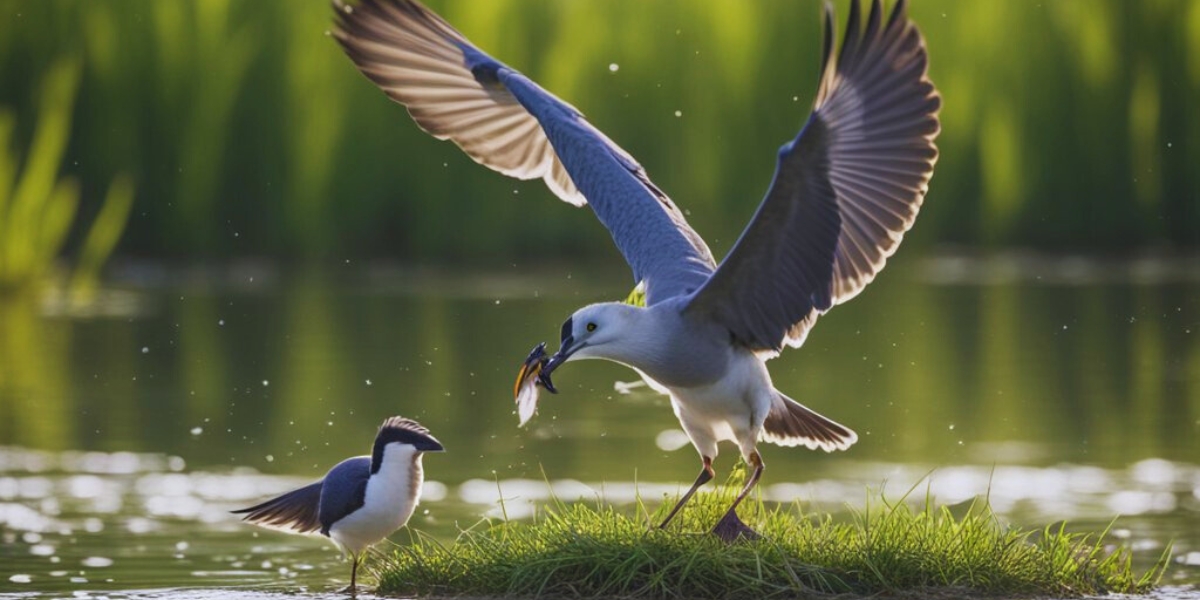Birds have evolved a variety of physical and behavioral adaptations that allow them to successfully find and consume food. Their specialized beaks, talons, sharp vision, keen sense of smell, and foraging strategies are all finely tuned to help birds locate nutrients and energy sources. Different birds use these attributes to take advantage of the diverse food sources available in their habitats, including insects, seeds, fruits, nectar, fish, and even other animals. However, habitat loss, competition, climate change, and other threats are making it increasingly challenging for wild birds to access sufficient food.
Physical Adaptations for Feeding
Birds rely on several key physical features to help them locate, harvest, and consume food:
Beaks
The size and shape of a bird’s beak is adapted for its diet. Thick, strong beaks crack hard nuts and seeds. Long, slender bills probe for insects. Curved bills tear meat. Spoon-shaped bills siphon nectar. Different beak types allow each species to utilize the common food sources in its environment.
Feet and Claws
Talons and strong feet equipped with opposing digits allow raptors to firmly grasp and carry prey. Waterbirds have webbed feet for paddling and feet placement on aquatic plants to catch fish. Songbirds have slender feet well-suited for perching among branches while foraging.
Vision
Most birds have excellent, high-definition vision. Raptors spot prey from great heights. Waterbirds see well underwater to catch fish. Many birds see ultraviolet light, enhancing their ability to find flowers, fruits, and insects.
Smell
Birds use their sense of smell to locate food, identify edible vs. toxic food, and assess food freshness. Scavengers like vultures can detect dead animals from miles away. Seabirds smell their prey and foraging sites while out at sea.
Behavioral Adaptations for Finding Food
In addition to physical features, feeding behaviors and strategies help birds efficiently locate and consume calories and nutrients:
Foraging Strategies
Different foraging strategies are employed based on food type, habitat, and competition. These include chasing insect swarms, picking ticks off mammals, grazing on grass seeds, trapping fish in coral reefs, kleptoparasitism by stealing food from other birds, and cooperatively hunting in packs.
Food Caching
Some birds cache excess food for later recovery during lean times. Nuthatches hide seeds in tree bark crevices. Jays conceal thousands of acorns to unearth in winter. Cached food sustains birds when resources are scarce.
Following Other Birds
Flocking birds exchange information on food locations while foraging together. Gulls and vultures follow each other to carrion. Honeyguides lead other birds to bee hives for collaborative feeding. Following others helps birds find unpredictable food bonanzas.
Spatial Memory
Birds often remember specific locations, routes, and spatial maps that allow them to return to productive feeding sites, scattered food caches, distant fruiting trees, and more. Strong spatial recall enhances foraging success.
Common Food Sources
The key food staples in most birds’ diets include:
Insects
Insects provide abundant protein. Flycatchers, swifts, nightjars, and others specialize in catching insects on the wing. Grouse and turkeys scratch leaf litter for beetles and larvae. Warblers glean caterpillars from leaves. Even seed-eating birds feed insects to chicks for growth.
Seeds and Nuts
Packed with calories, fats, and fiber, seeds and nuts sustain many birds. Finches and doves have beaks adapted for cracking seeds. Jays and woodpeckers feast on nuts like acorns. Granivorous birds play an important ecological role by dispersing seeds.
Fruit
Berries and fleshy fruits are sought out by birds like hornbills, cotingas and frugivorous parrots that help disseminate the seeds. Fruits provide hydration along with sugars and nutrients.
Nectar
Specialized nectarivores like hummingbirds, sunbirds and honeyeaters have long beaks and tongues to siphon nectar, an efficient energy food source. Pollen caught during feeding provides protein.
Fish and Meat
Seabirds like albatrosses skillfully snatch fish from the ocean surface. Vultures, eagles, hawks and other raptors prey on small mammals, reptiles and amphibians. Carnivorous and omnivorous birds get protein from animal foods.
Feeding Adaptations in Different Bird Groups
Specific bird groups demonstrate unique adaptations tailored to take advantage of certain food resources:
Raptors
Talons, sharp hooked beaks, keen vision and powerful flight let raptors seize and consume vertebrate prey. Kites have delicate beaks for snatching insects. Eagles and owls have strong beaks for tearing flesh.
Waterbirds
Aquatic birds have webbed feet for swimming and skewer-like beaks to spear fish. Flamingos filter-feed on algae. Shorebirds probe mudflats for invertebrates. Goose beaks grasp grass.
Songbirds
Warblers glean insects from foliage. Thrashers crush snails on rocks. Finches have cone-shaped beaks that crush seeds. The orioles sip nectar. Diverse beaks match food choices.
Birds of Paradise
Elaborately plumed males evolved courtship displays to access fruits and arthropods monopolized by choosy females. Their drab partners provide essential access to these resources.
Challenges Birds Face Accessing Food
Despite their adaptations, birds face escalating challenges obtaining sufficient nutrition:
Habitat Loss
Logging, agriculture, and development destroy the habitats and food sources birds rely on. Nesting sites and foraging areas continue to decline.
Competition for Resources
Invasive species, overgrazing by livestock, and expanding human populations intensify competition for limited habitat and food. Aggressive introduced birds often dominate natives.
Climate Change
Changing weather, seasons, plant communities, and insect availability disrupt traditional food sources. Migrations and egg laying become mismatched with food supply.
Dangers While Feeding
Predation, motor vehicles, communication towers, and poisons take a heavy toll on foraging birds. Meeting basic nutritional needs has become an obstacle course.
Providing Food for Pet and Captive Birds
For domesticated and captive birds, owners must provide appropriate nutrition and opportunities for natural feeding behaviors:
Commercial Diets
Seed mixes, pellets, chopped produce, and supplements formulated for certain species, life stages, and health needs ensure nutritional completeness.
Foraging Toys and Puzzles
Food hidden in tubes, boxes, shredded paper, and toys encourages natural foraging instincts and provides enrichment.
Training for Veterinary Care
Positive reinforcement training teaches birds to voluntarily eat special diets, take medications, and cooperate with medical exams for better health.
People Also Read:
Conclusion
Specialized physical attributes like beaks and feet, combined with behavioral feeding strategies, allow different bird species to exploit diverse food sources from fruit and nectar to fish and small vertebrates. But habitat destruction, competition for limited resources, climate change disruption, and hazards while foraging increasingly threaten birds’ ability to access the nutrition they need. Supporting habitat conservation and reducing further impacts can help protect the future of avian wildlife.
People Also Read:
FAQs
What adaptations help birds find food?
Birds use sharp vision, keen smell, different beak shapes, clawed feet, spatial memory, foraging flocking, and food caching to locate varied nutrients and energy sources.
What do seed-eating birds use to get their food?
Finches, doves, and other granivorous birds have cone-shaped beaks ideally adapted for cracking and husking seeds. Strong feet help perch on seed heads. Flocking, memory, and seed caching aid discovery.
How do raptors get their food?
Sharp talons, hooked beaks, keen binocular vision, spatial memory, and soaring flight allow raptors to effectively spot, pursue, and snatch vertebrate prey both on the ground and in the air. Strong grasping feet carry prey, while hooked upper beaks tear flesh.
What helps pelicans catch fish?
Pelicans have very large pouched beaks that can scoop up many fish at once. These beaks drain water while trapping fish inside the pouch. Pelicans also have partially webbed feet for surface diving and swimming to corral fish schools.
Why do hummingbirds have long beaks?
The long, slender beaks of hummingbirds are adapted to reach inside tubular flowers and sip honing nectar. Their bifurcated tongues aid in lapping up this high-energy food source. Hummingbird beaks perfectly match the shape of preferred flowers.
How do migrating birds find food in new areas?
Migrating birds rely on remembered sites and spatial maps to relocate productive feeding locations. Flocking and food sharing provides updates on current resources. Flexible foraging lets them exploit new seasonal foods along migration routes.
What prevents some pet birds from naturally feeding?
Pet birds removed from the wild early or hand-raised may miss learning essential foraging skills. Clipped wings, limited space, and a lack of appropriate food puzzles can inhibit natural feeding behaviors. Training is needed to nurture these instincts.

